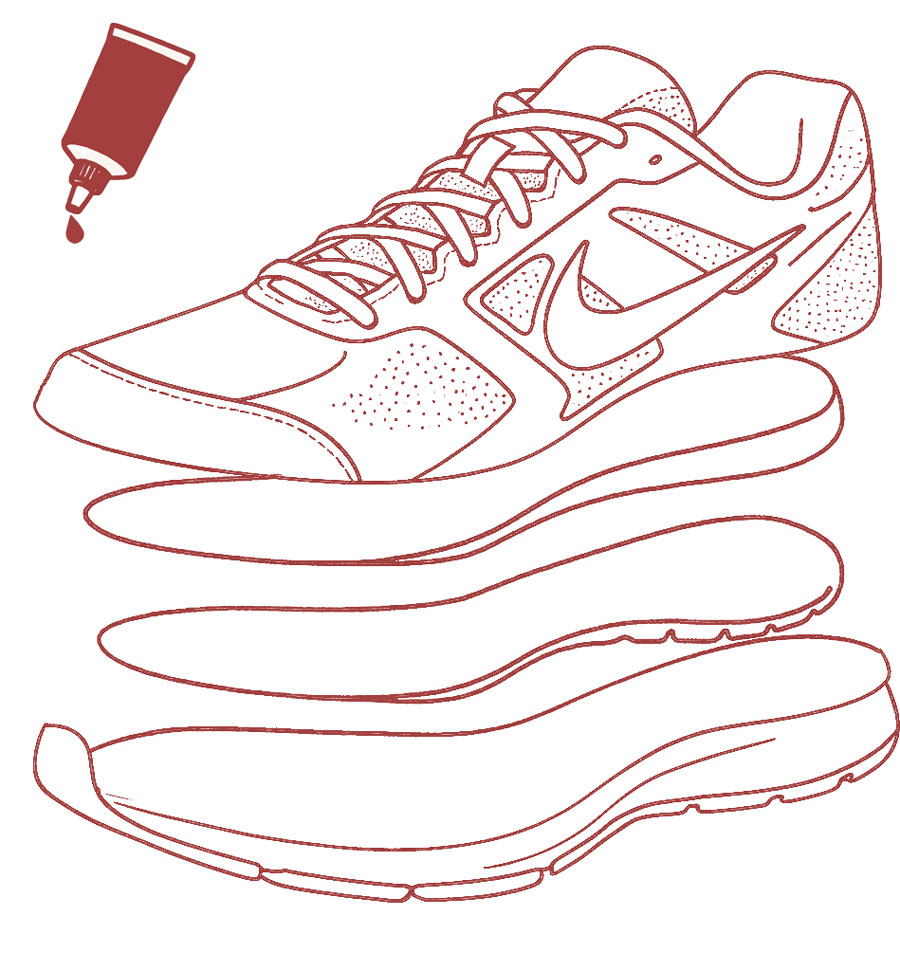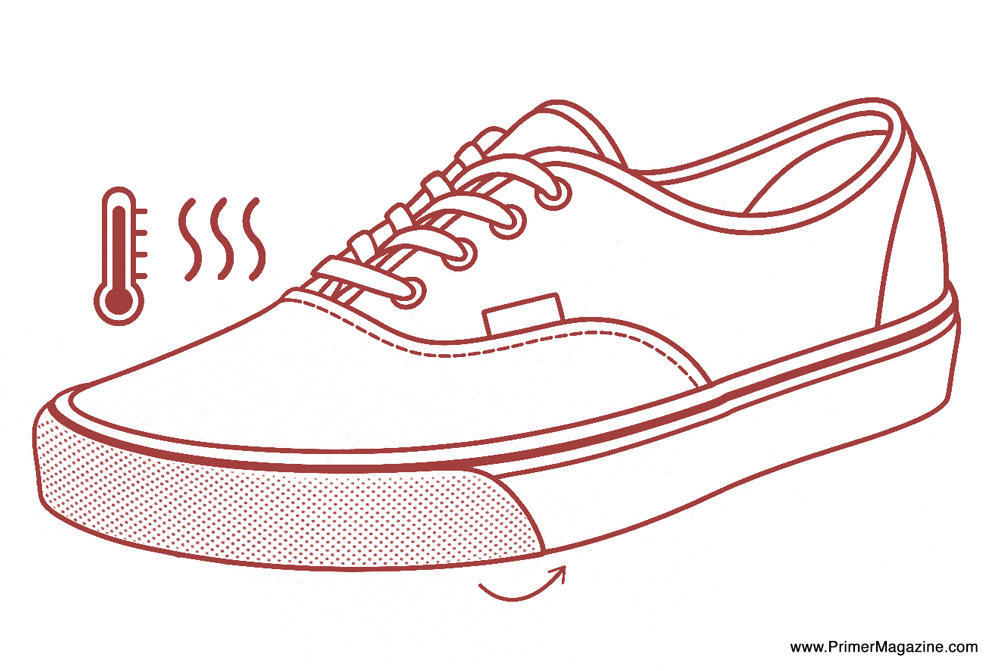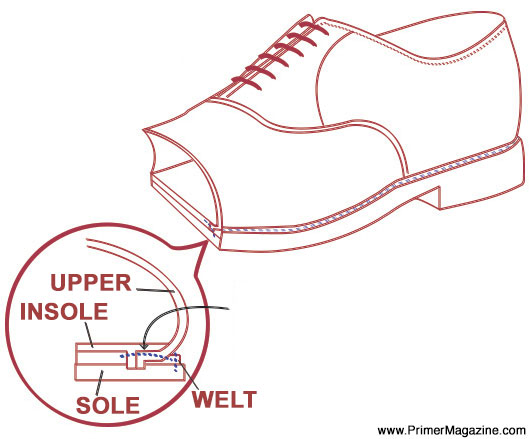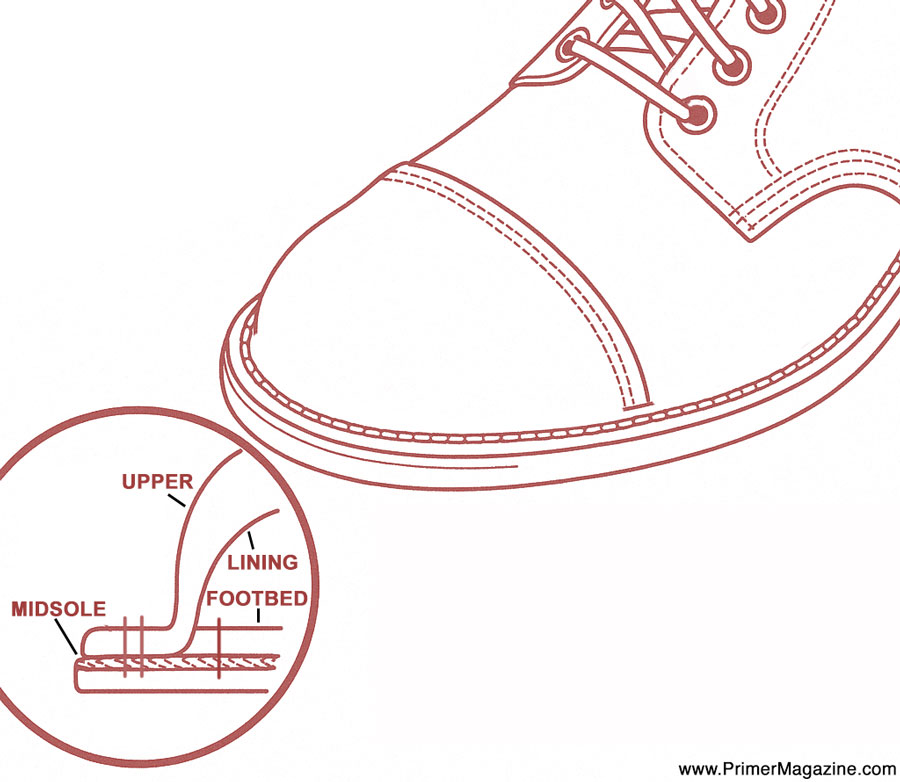The nice, the unhealthy, and the boogiemen of shoe building.
A whole lot of guys begin questioning about shoe building as soon as they’ve moved previous their first spherical of disposable costume sneakers. You realize those—look first rate sufficient out of the field, however after six months the only real peels or the leather-based creases like paper. That query comes up: What makes some sneakers maintain up for years, whereas others appear to age in a single day? And is it immediately associated to cost?
The reply, most frequently, comes all the way down to how the only real is hooked up to the higher. That connection—its methodology and its supplies—has extra to do with longevity than branding and even leather-based high quality.
Importantly although, every building methodology, even these thought of probably the most or least sturdy, has its professionals and cons. What exercise the footwear is meant for use for is really what determines whether or not the development used was primarily based on sturdiness or cost-cutting.
Earlier than we get into the development strategies, we have to begin with a fast Primer on
Fundamental Shoe Anatomy
The Higher
That is the fabric above the only real that covers the foot—sometimes leather-based or canvas. It contains elements just like the vamp, heel, eyelets, and extra.
The Insole
The floor contained in the shoe that your foot rests on. It may be cushioned, contoured, or leather-lined, relying on the design.
The Outsole
The underside of the shoe that touches the bottom. Outsoles may be manufactured from leather-based, rubber, or an artificial mix.
The Welt
A strip of leather-based or different materials that sits between the higher and outsole on higher-quality sneakers. It performs a key function within the sturdiness and resoling potential.
The Final
A 3D mannequin of a foot used throughout building. The form and construction of the final decide how the ultimate shoe matches and appears. Inside a model, totally different shoe strains could use totally different lasts which lead to totally different matches, and could also be talked about within the product description.
The totally different shoe building strategies should not merely “good” or “unhealthy,” or a mirrored image of high quality. Understanding which methodology can greatest be used for what sort of shoe will assist you reinforce buying selections. Figuring out how to spend on sneakers will hold you from spending extra on sneakers.
Chilly Cement Development
Invented: Mid-Twentieth century (mass adoption post-WWII), expanded with artificial adhesives


Chilly cementing is the usual methodology for attaching outsoles in most of immediately’s athletic and trend sneakers. It makes use of robust artificial adhesives to bond the higher or midsole unit to the rubber or foam outsole—no warmth required.
After the shoe’s higher is assembled (usually with Strobel stitching, beneath, or different inside strategies), the only real unit is glued on utilizing high-strength cement. The bond units with out warmth, permitting manufacturers to make use of trendy foams like EVA, Phylon, or polyurethane that might soften or deform beneath warmth.
What works: Trainers, trainers, streetwear sneakers, costume sneakers, foam-cushioned informal sneakers. Chilly cementing allows lighter supplies and sophisticated sole designs with air items, flex grooves, or molded shapes.
What doesn’t: Chilly cemented sneakers aren’t constructed to be resoled. As soon as the adhesive bond or foam cushioning wears out, the shoe is successfully on the finish of its life. Sturdiness varies by use, however restore choices are restricted.
Elements like the kind of glue, how nicely the supplies are prepped, and the way a lot stress and time are used throughout urgent all affect sturdiness. Skipping steps or utilizing cheaper supplies can result in soles separating early.
Chilly cementing varies in high quality, and sadly, it’s not at all times straightforward to identify the distinction simply by trying however there are a couple of clues. Higher chilly cemented sneakers, like these from respected athletic or way of life manufacturers, use stronger adhesives, prep supplies correctly, and infrequently incorporate design options like cup soles that wrap the higher for a safer bond.
The tactic itself isn’t inherently weak, however the execution makes all of the distinction.
It’s usually secure to say that if a product web page doesn’t point out the development methodology, it’s in all probability cemented—particularly for sneakers beneath $200.
Most manufacturers spotlight Goodyear welted or Blake stitched building (each beneath) as a promoting level as a result of it provides worth, longevity, and resole-ability. Cemented building is cheaper and quicker to supply, and types utilizing it usually focus advertising and marketing on fashion, consolation, or supplies slightly than how the only real is hooked up.
There are exceptions—some small or heritage-inspired manufacturers won’t checklist it clearly, or a Blake-stitched shoe might fly beneath the radar—however in mainstream retail, no point out normally means cemented.
Tips on how to spot it: There’s normally no stitching (or if there’s, its ornamental and molded into the rubber) across the outsole, only a clean glue bond the place the only real meets the higher. Gently flexing the shoe could reveal separation or a visual glue line on cheaper pairs.
Strobel Development
Invented: Mid-1900s, named after the Strobel Machine Co. in Germany


Strobel building refers to how the higher is hooked up to the insole unit earlier than the only real is utilized. On this methodology, a cloth insole board is stitched on to the sting of the higher, forming a versatile, sock-like base. This stitched higher unit is then sometimes chilly cemented to the outsole.
Strobel is usually invisible to the client—it’s what’s beneath the foot, not beneath the shoe. However it’s a significant motive why efficiency sneakers really feel mushy and pliable in comparison with leather-based costume sneakers.
What works: Ultimate for sneakers the place flexibility, gentle weight, and a broken-in really feel are important. Consider Nike’s Free or Flyknit strains, or most trendy trainers. The development permits for pure foot motion and breathability.
What doesn’t: Strobel-built sneakers are onerous to restore. There’s no welt or structural basis for resoling. Similar to chilly cement building, as soon as the only real wears out or the cushioning flattens, the sneakers have to get replaced.
Tips on how to spot it: You possibly can’t see it from the surface, however when you carry the insole, you would possibly spot zig-zag stitching attaching the higher to a skinny material layer beneath.
Blake Development
Invented: 1856 by Lyman Reed Blake, who labored for the Singer Stitching Machine Firm.


Streamlined and modern, the higher is wrapped beneath the insole and immediately stitched to the outsole with a single sew working by means of all layers from the within. It’s a product of the Industrial Revolution and nonetheless frequent in Italian footwear immediately.
What works: Slim-profile costume sneakers the place you need a clear edge and a light-weight, versatile really feel. Blake building additionally permits for resoling—so long as the cobbler has the best gear.
What doesn’t: Much less water resistant than Goodyear (beneath), and the inside sew can typically be felt underfoot. Not each cobbler can work on them, which limits restore choices in some areas.
Tips on how to spot it: Look contained in the shoe, when you really feel stitching beneath the insole however don’t see any alongside the sting of the only real, it’s probably Blake-constructed.
Vulcanized Development
Invented: Mid-1800s, primarily based on Charles Goodyear Sr.’s vulcanization course of (patented in 1844)


Widespread in canvas sneakers like Vans and Converse, this course of bonds uncured rubber soles to the higher, then bakes your entire shoe in a vulcanizing oven. The warmth, round 230°F, hardens the rubber right into a sturdy, springy sole and locks it to the higher with out stitching or glue.
What works: It’s excellent for informal sneakers made with heat-resistant supplies like canvas, suede, or leather-based. The result’s versatile, grippy, and ideal for skateboarding or streetwear.
What doesn’t: Vulcanization limits materials decisions. Something that may soften like nylon or EVA can’t be used. It additionally requires a specialised manufacturing facility setup, so manufacturing is usually extra area of interest. You gained’t discover this methodology utilized in high-end costume sneakers, and it’s not designed for resoling.
Tips on how to spot it: The rubber sidewall wraps up over the higher with none stitching, and the entire shoe feels springy with a barely rubbery odor, once more, assume Vans or Converse.
Goodyear Welt Development
Invented: Patented in 1869 by Charles Goodyear Jr. (son of the rubber vulcanization man)


The basic normal for sturdy, repairable footwear. The higher and insole are sewn to a leather-based welt: a strip that runs across the edge. A second sew then attaches the welt to the outsole. Between these layers? A mattress of cork that molds to your foot over time.
What works: Gown boots, oxfords, brogues, or something you wish to put on for a decade. Goodyear sneakers are constructed to be resoled repeatedly.
What doesn’t: The additional construction provides weight and rigidity. Takes time to interrupt in earlier than comfy. Often costlier, however for good motive.
Some manufacturers additionally use a hybrid referred to as Blake Speedy, the place the higher is Blake stitched to a midsole, which is then stitched to the outsole—providing extra sturdiness whereas preserving a slim profile.
Tips on how to spot it: Search for seen stitching across the outsole’s edge and a small ridge the place the welt barely extends. These sneakers are inclined to really feel structured and weighty.
Stitchdown Development
Origin: Conventional bootmaking, with robust roots in American workwear and Pacific Northwest heritage manufacturers


The higher is flared outward and stitched on to the midsole or outsole—no welt is used. This creates a broad, visibly stitched perimeter the place the higher folds out and turns into a part of the only real construction.
What works: A go-to for rugged, water resistant boots. Manufacturers like Viberg, White’s, Nick’s, and Danner have made stitchdown synonymous with sturdiness. It additionally seems in lower-cost fashions like Clarks Desert Boots and a few Purple Wing choices, although high quality varies.
What doesn’t: Resoling may be difficult. If a cobbler doesn’t rigorously reuse the unique sew holes, it might probably injury the flared leather-based and compromise the higher. Not each store is provided to do it cleanly. Often it’s a must to ship them again to the model to be labored on.
Tips on how to spot it: Search for the higher leather-based visibly folded outward and stitched flat in opposition to the sting of the only real—there’s no welt, simply uncooked leather-based and thick stitching across the base. The profile is broad, and the aesthetic leans rugged and useful.
Norwegian (Storm Welt) Development
Origin: Conventional European bootmaking
A heavy-duty variation of Goodyear welting, Norwegian building makes use of a visual double sew that runs by means of the higher and welt, then into the outsole. It additionally usually incorporates a raised storm welt that curls upward alongside the perimeter, including water resistance. The underlying building continues to be Goodyear—the storm welt is a selected fashion of welt used within the course of.
What works: Alpine-style boots, winter-ready costume boots, heritage workwear.
What doesn’t: Bulkier profile and better value. Usually extra style-specific than on a regular basis sneakers.
Tips on how to spot it: You’ll see two rows of sewing and a raised, curved welt around the shoe’s edge, giving it a chunkier, extra rugged profile.


